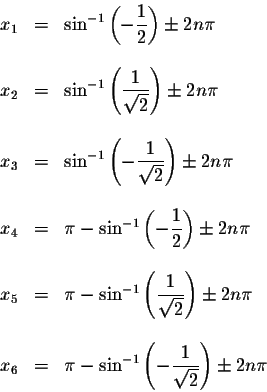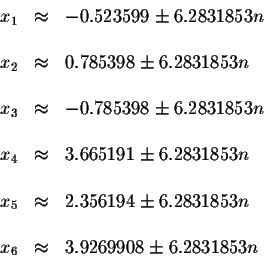
 SOLVING TRIGONOMETRIC EQUATIONS
SOLVING TRIGONOMETRIC EQUATIONS

Note: If you would like a review of trigonometry, click on trigonometry.
Example 1: Solve for x in the following equation.
There are an infinite number of solutions to this problem.
Let's manipulate the equation to make solving for x a little easier. Rewrite
the left side of the equation in an equivalent factored form.

The product of factors equals zero if at least one of the factors equals
zero. This means that
![]() if
if
![]() or
or
![]() or
or
![]()
![]()
We just transformed a difficult problem into two easier problems. To find
the solutions to the original equation,
![]() ,
we find the
solutions to the equations
,
we find the
solutions to the equations
![]() ,
,
![]() ,
or
,
or
![]()
![]()

How do we isolate the x in each of these equations? We could take the inverse (arcsine) of both sides of each equation. However, the sine function is not a one-to-one function.
Let's restrict the domain so the function is one-to-one on the restricted
domain while preserving the original range. The graph of the sine function
is one-to-one on the interval
![$\left[ -\displaystyle \displaystyle \frac{\pi }{2},\displaystyle \displaystyle \frac{\pi }{2}%
\right] .$](img11.gif) If we restrict the domain of the sine function to that interval ,
we can take the arctangent of both sides of each equation.
If we restrict the domain of the sine function to that interval ,
we can take the arctangent of both sides of each equation.

In each of these cases, x is the reference angle. We know that
![]() ,
therefore
,
therefore
Since the period of ![]() equals
equals ![]() ,
these solutions will repeat
every
,
these solutions will repeat
every ![]() units. The exact solutions are
units. The exact solutions are

The approximate values of these solutions are

You can check each solution algebraically by substituting each solution in
the original equation. If, after the substitution, the left side of the
original equation equals the right side of the original equation, the
solution is valid.
You can also check the solutions graphically by graphing the function formed by subtracting the right side of the original equation from the left side of the original equation. The solutions of the original equation are the x-intercepts of this graph.
Algebraic Check:
Check solution

Left Side:

Right Side:
Since the left side of the original equation equals the right side of the
original equation when you substitute
-0.5235988 for x, then
-0.5235988 is a solution.
Check solution

Left Side:

Right Side:
Since the left side of the original equation equals the right side of the original equation when you substitute 0.785398 for x, then 0.785398 is a solution.
Check solution

Left Side:

Right Side: ![]()
Since the left side of the original equation equals the right side of the original equation when you substitute -0.785398 for x, then -0.785398 is a solution.
Check solution

Left Side:

Right Side: ![]()
Since the left side of the original equation equals the right side of the original equation when you substitute 3.665191 for x, then 3.665191 is a solution.
Check solution

Left Side:

Right Side:
Since the left side of the original equation equals the right side of the
original equation when you substitute 2.356194 for x, then 2.356194 is a solution.
Check solution

Left Side:

Right Side:
Since the left side of the original equation equals the right side of the
original equation when you substitute 3.9269908 for x, then 3.9269908 is a solution.
We have just verified algebraically that the exact solutions are
 ,
and
,
and
 ,
,
 ,
,
 ,
,
 ,
and
,
and
 and these solutions repeat every
and these solutions repeat every ![]() units. The approximate values
of these solutions are
units. The approximate values
of these solutions are
![]() ,
0.785398, -0.785398, 3.665191, 2.356194 and 3.9269908 and these solutions repeat every
,
0.785398, -0.785398, 3.665191, 2.356194 and 3.9269908 and these solutions repeat every
![]() units.
units.
Graphical Check:
Graph the function
![]() ,formed by the left side of the equation. The x-intercepts of the graph are
the real solutions.
,formed by the left side of the equation. The x-intercepts of the graph are
the real solutions.
Note that the graph crosses the x-axis many times indicating many solutions. Let's check a few of these x-intercepts against the solutions we derived.
Verify the graph crosses the x-axis at
-0.523599. Since the period is
![]() ,
you can verify that the graph also crosses the
x-axis again at
-0.523599+6.2831853=5.7595863 and at
,
you can verify that the graph also crosses the
x-axis again at
-0.523599+6.2831853=5.7595863 and at
![]() ,
etc.
,
etc.
Verify the graph crosses the x-axis at 0.785398. Since the period is
![]() ,
you can verify that the graph also crosses the x-axis again at
0.785398+6.2831853=7.06858 and at
,
you can verify that the graph also crosses the x-axis again at
0.785398+6.2831853=7.06858 and at
![]() ,
etc.
,
etc.
Verify the graph crosses the x-axis at
-0.785398. Since the period is
![]() ,
you can verify that the graph also crosses the
x-axis again at
-0.785398+6.2831853=5.497787 and at
,
you can verify that the graph also crosses the
x-axis again at
-0.785398+6.2831853=5.497787 and at
![]() ,
etc.
,
etc.
Verify the graph crosses the x-axis at 3.665191. Since the period is
![]() ,
you can verify that the graph also crosses the x-axis again at
3.665191+6.2831853=9.94838 and at
,
you can verify that the graph also crosses the x-axis again at
3.665191+6.2831853=9.94838 and at
![]() ,
etc.
,
etc.
Verify the graph crosses the x-axis at 2.356194. Since the period is
![]() ,
you can verify that the graph also crosses the x-axis again at
2.356194+6.2831853=8.639379 and at
,
you can verify that the graph also crosses the x-axis again at
2.356194+6.2831853=8.639379 and at
![]() ,
etc.
,
etc.
Verify the graph crosses the x-axis at
3.9269908. Since the period is
![]() ,
you can verify that the graph also crosses the
x-axis again at
3.9269908+6.2831853=10.210176 and at
,
you can verify that the graph also crosses the
x-axis again at
3.9269908+6.2831853=10.210176 and at
![]() ,
etc.
,
etc.
Note: If the problem were to find the solutions in the interval
![]() ,
then you choose those solutions from the set of infinite
solutions that belong to the set
,
then you choose those solutions from the set of infinite
solutions that belong to the set
![]()
![]() 2.356194, 3.665191,
3.9269908, 5.497787 and 5.7595863
2.356194, 3.665191,
3.9269908, 5.497787 and 5.7595863
If you would like to test yourself by working some problems similar to this example, click on Problem.
If you would like to go back to the equation table of contents, click on Contents.

